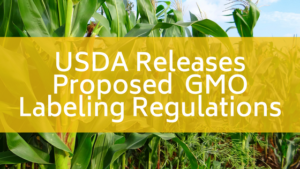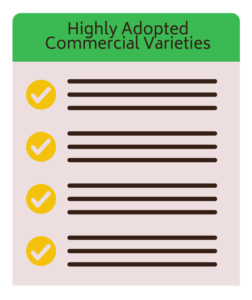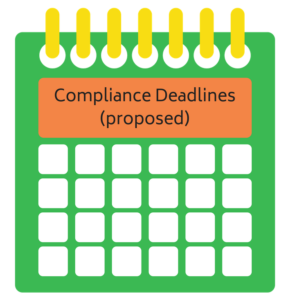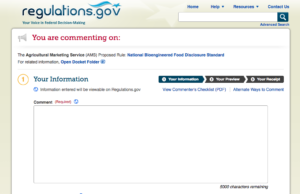T he Agricultural Marketing Service (AMS) of U.S. Department of Agriculture recently released its proposed rule for a National Bioengineered Food Disclosure Standard (“NBFDS”). When finalized, this rule will create a nationwide labeling requirement for foods containing bioengineered ingredients. USDA is accepting comments on the proposed regulation until July 3, 2018.
he Agricultural Marketing Service (AMS) of U.S. Department of Agriculture recently released its proposed rule for a National Bioengineered Food Disclosure Standard (“NBFDS”). When finalized, this rule will create a nationwide labeling requirement for foods containing bioengineered ingredients. USDA is accepting comments on the proposed regulation until July 3, 2018.
This proposed rule was issued pursuant to the National Bioengineered Food Disclosure Law of 2016, a federal law that was passed weeks after Vermont’s Act 120, the first-enforced state law requiring the labeling of food produced with genetic engineering, went into effect. A key purpose of the National Bioengineered Food Disclosure Law is to create a single standard for the labeling of bioengineered foods and avoid having a patchwork of state GMO labeling laws with different and potentially conflicting requirements.
The USDA’s proposed rule would require a disclosure on certain food products indicating that they are or contain a “bioengineered food.” If this terminology is unfamiliar to you, you are not alone — it represents a significant shift in how we describe foods and ingredients produced through the use of genetic engineering. “Genetically Engineered, ”“Genetically Modified,” and “GMO” are common parlance. The proposed standard would omit these commonly used phrases in favor of a more scientifically accurate but far less familiar designation: “bioengineered food” or “BE” for short.
For purposes of the NBFDS, “bioengineered food” is defined to mean and include “a food that contains genetic material that has been modified through in vitro recombinant deoxyribonucleic acid (DNA) techniques and for which the modification could not otherwise be obtained through conventional breeding found in nature.” Thus, bioengineered is narrower than genetically modified, as it is typically understood and was defined in earlier state laws. BE foods are only those created through transgenic modification, which involves the splicing of genes from one species into another. Food and ingredients produced through the use of newer and emerging genome editing technologies such as CRISPR may not fall within the proposed definition of BE foods.
Applicability
The proposed NBFDS would apply to all human foods subject to the labeling requirements of the Federal Food, Drug And Cosmetic Act, including “raw produce, seafood, dietary supplements, and most prepared foods, such as breads, cereals, non-meat canned and frozen foods, snacks, desserts, and drinks.” It would apply to both products packaged for retail sale and food sold in bulk bins at retailers.
The BE disclosure requirement also applies to some of the meat, poultry and egg products regulated by the USDA under the Federal Meat Inspection Act, the Poultry Poultry Products Inspection Act, or the Egg Products Inspection Act, provided that an ingredient regulated by the FDA predominates. Thus, a BE disclosure would not be required on a processed product in which meat or poultry is the primary ingredient, even if it contains BE ingredients.
Foods derived from animals given BE feed would not be required to make a disclosure. For example, no disclosure would be necessary on milk or cream that was produced by cows fed “Round-up Ready” corn or soy, but a disclosure would be required on vanilla pudding made from the same milk if it contained corn starch derived from BE corn.
All certified organic foods would be automatically exempt from the BE disclosure requirements. Under USDA’s National Organic Program, such foods are not permitted to be bioengineered or to contain bioengineered ingredients.
Food that is served in restaurants, bars, cafes, supermarket delis, salad bars, lunchrooms, “and other food enterprises located within retail establishments that provide ready-to-eat foods that are consumed either on or outside of the retailer’s premises” would not be subject to BE disclosure requirements.

Lists of Bioengineered Foods
Under the proposed regulation, a BE disclosure would be required only if a food is on, or contains a food on, a USDA-defined list of commercially available BE foods unless the manufacturer has deliberately sourced non-BE versions of the listed foods. USDA is developing two lists of commercially available bioengineered foods: one for “highly adopted commercially available bioengineered foods,” such as canola, soy, cotton, field corn, and sugar beet, which have a cultivation rate of 85 percent or more in the United States; and one for not highly adopted commercially available bioengineered foods that currently have adoption rates of under 85 percent, such as papaya, sweet corn, apples, potato, and summer squash.
Proposed Exemptions
The USDA has proposed a number of possible exemptions from BE disclosure requirements, for which it seeks public comments. For example, the USDA may exempt highly refined sugars and oils, including those made from genetically modified corn, soybeans, and sugar beets, because the refinement process typically destroys all modified DNA. As reported by the Washington Post, this could “effectively exempt as much as 70 percent of covered food products from GMO labeling.”
The proposed rule also envisions an exemption for foods that contain minimal amounts of bioengineered ingredients. Foods could be exempted from disclosure requirements if “an ingredient contains a bioengineered substance that is inadvertent or technically unavoidable” and does not exceed a certain percentage of the finished product. The USDA is considering limits of either 5% or 0.9% by weight. These allowances are designed to provide some leeway and avoid labeling violations when small amounts of bioengineered material may be present in a finished product either because bioengineered crops were grown in close proximity to non-bioengineered crops or because of cross-contact between GMO and non-GMO ingredients that were processed on shared machinery or in common facilities. While still objectively small, the 5% threshold is significantly higher than the 0.9 percent thresholds set by Chinese, Russian and European Union regulations. It also exceeds the threshold set by the Non-GMO Project voluntary third-party certification program.
Another option proposed by USDA, which is likely to be controversial, would exempt from disclosure foods containing up to 5% by weight BE ingredients, whether the presence of BE material in such ingredients is avoidable or not. If this exemption is adopted, it would affirmatively allow use of bioengineered ingredients up to the proposed threshold.
Methods of Making the Disclosure
The required BE disclosure can be made using one of four methods: written text disclosure, symbol disclosure, electronic or digital link disclosure or text-message disclosure.
Text Disclosures
Required disclosures under the NBFDS need to be of a “sufficient size and clarity to appear prominently and conspicuously on the label, making it likely to be read and understood by the consumer under ordinary shopping conditions.” When making a disclosure on a product that is or contains an ingredient on the highly adopted list, the written text disclosure must state that it is a “bioengineered food” or “contains a bioengineered food ingredient.” On the other hand, the when disclosing a food that is, contains, or may contain a food not on the highly adopted list, then the text disclosure can use “may” statements, such as “may contain a bioengineered food ingredient” or “may be a bioengineered food.” No acronyms — BE or GMO — may be used in the text disclosures.
Symbol Disclosures
The USDA has presented three alternative symbol options — all of which contain the abbreviation “BE” and evoke sunshine and/or smiles — for public comment. These symbols intentionally offer visual appeal to avoid the perception of a “warning” to consumers. Moreover, the use of a new acronym seems designed to shed the stigma associated with the term “GMO”. Given the generally negative consumer perceptions of bioengineered foods, many comments about the artwork and acronym can be expected.



 Electronic, Digital Link, & Text Message Disclosures
Electronic, Digital Link, & Text Message Disclosures
Interestingly, the proposed rule represents the first time that the USDA has explored permitting an electronic or a text-message disclosure via regulation. Under the proposed rule, companies may comply with bioengineered disclosure requirements without noting the presence of bioengineered foods directly on the product label. Instead, an electronic or digital link disclosure such as a QR code may be used, provided that the label says something like: “Scan here for more food information.” Alternatively, it would be permissible to include a label statement directing consumers to “Text [number] for more food information.” When opting to use electronic disclosure, the producer need not use any term, phrase, or symbol expressly referencing bioengineered foods on the physical label.
The USDA commissioned Deloitte to study consumer access to and use of technology to assess efficacy of electronic disclosure. The results were mixed and indicated that at least 85% of consumers struggle when using apps for scanning digital links. Because it is not clear whether consumers will take the extra step of scanning or sending a text just to determine whether the food has bioengineered ingredients, these disclosure options have been criticized by some as obfuscating rather than illuminating. Others see the disclosure options as widening the digital divide (especially in rural areas without robust cellular service) and disadvantaging lower income consumers, as well as those who do not have, or are not comfortable using all the features of, smartphones.
Timeline for Compliance
The proposed rule sets compliance dates of Jan. 1, 2020 for food manufacturers with $10 million or more in annual receipts. Small food manufacturers with between $2.5 and $10 Million in annual receipts would have an additional year to comply. Very small manufacturers with less than $2.5 million in annual receipts would be exempt from the disclosure requirements. That said, the proposed rule would allow food manufacturers to use their existing inventory of food and labels until Jan. 1, 2022, or until regulated entities use up their remaining inventories, whichever comes first. While it is possible that the USDA could extend these deadlines through future rulemaking, it is wise to plan for compliance with these dates in mind, particularly because the USDA has intentionally aligned them with the compliance dates for FDA’s new Nutrition Facts, Supplement Facts, and Serving Size rules.

Even though federal law preempts Vermont’s Act 120 and other similar state laws, many food producers who market their products within Vermont or nationally had already begun complying with the state law when the National Bioengineered Food Disclosure Law was passed. As a result, since 2016, it has become common to see the phrases “Produced with Genetic Engineering,” “Partially Produced with Genetic Engineering,” “May be Produced with Genetic Engineering” (as applicable) on food products. Once the USDA finalizes the rule, producers will need to replace the existing Act 120-inspired labeling language with federally compliant disclosures.
Reaction to the Rule
Advocates of GMO-labeling laws who have long lobbied on behalf of a consumer’s “Right to Know” are already arguing that the proposed exemptions, narrow definition of bioengineered food, and use of “BE” instead of “GMO” create loopholes that undermine the interests of consumers who wish to avoid genetically engineered foods for a range of personal reasons including environmental, ethical, religious, individual or public health concerns. Some have noted that current third party GMO-free certifications, such as the Non-GMO Project have stricter standards than the narrowly defined proposed BE label and are likely to remain relevant to consumers who want to avoid foods produced through the use of genetic engineering. Producer groups gave the rule a warmer reception and expressed enthusiasm for the landmark allowance of digital disclosure methods.
Public Comment
A 60 day public comment period on the proposed rule began on May 4, 2018. The USDA indicated that it will not extend the comment period because Congress mandated that the proposed rule be finalized by July 29, 2018. That said, Secretary of Agriculture Sonny Perdue has also acknowledged that the USDA will not meet the deadline and plans to finalize the rule “later this year.” The Agency invites comments on all aspects of the NBFDS, but appears particularly interested in receiving comments on the following topics:
- Whether ‘very small food manufacturers’ exempt from labeling requirements should be limited to those with annual revenues of $500,000 or $5 Million, in lieu of setting the cut-off at $2.5 Million;
- Whether the NBFDS should include a definition for “found in nature,” and if so, what it should be;
- Whether highly refined foods and ingredients that might not contain detectable levels of modified DNA but were produced using bioengineered commodities — such as sucrose, dextrose, corn-starch, high-fructose corn syrup, corn oil, canola oil, and soybean oil — should be covered;
- Whether the threshold for “inadvertent or technically unavoidable” amounts should be 5% or 0.9%;
- Whether enzymes, yeasts, and a number of other foods produced in controlled environments using bioengineering should be subject to the BE disclosure requirements;
- Whether the USDA should establish agreements with foreign governments that have their own labeling standards for bioengineered or genetically modified food under which each country would agree to recognize the other’s standards as comparable.
 Those who wish to weigh in should begin preparing their comments promptly and submit comments online through regulations.gov before July 3, 2018. If you are concerned about how this proposed rule may apply to your products, please reach out to Nicole or Lauren. We can help you better understand the potential compliance and disclosure obligations for your business and assist you with formulating comments to submit.
Those who wish to weigh in should begin preparing their comments promptly and submit comments online through regulations.gov before July 3, 2018. If you are concerned about how this proposed rule may apply to your products, please reach out to Nicole or Lauren. We can help you better understand the potential compliance and disclosure obligations for your business and assist you with formulating comments to submit.
